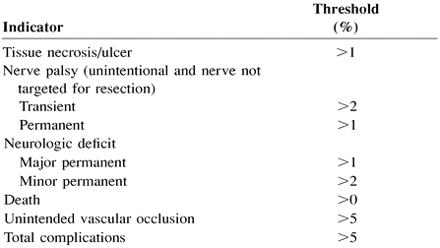Introduction
The embolization of vascular tumors of the head, neck, and CNS has become an important adjunct to the surgical treatment of these tumors. The procedure has resulted in reduced morbidity and mortality and helps to facilitate the removal of many of these tumors. In tumors that are not amenable to surgical therapy, embolization may occasionally be used as the primary mode of treatment.
These guidelines are to be used in quality improvement programs to assess head, neck, and brain tumor embolization procedures. The most important processes of care are patient selection, performing the procedure, and monitoring the patient. The outcome measures or indicators for these processes are indications, success rates, and complication rates. Outcome measures are assigned threshold levels.
Definitions
Tumor embolization is defined as the blockage of the vascular supply to a tumor. The blockage is usually performed via an endovascular approach but may also be performed by direct percutaneous injection of embolic agents into the tumor. The procedure is usually performed in a single session, simultaneously with diagnostic arteriography, but may also be performed in multiple staged sessions.
Ideally, an embolic agent is chosen that will block the very small vessels within the tumor but spare the adjacent normal tissue. Liquid embolic agents, such as ethanol or acrylic, and powdered particulate materials can penetrate into the smallest blood vessels of the tumor but need to be used very selectively because they can also cause the most damage to the adjacent normal tissues. Relatively large particulate agents, such as polyvinyl alcohol and Gelfoam, do not penetrate into the tumor as deeply but are also less likely to damage adjacent normal tissues. Embolic agents may be permanent or temporary.
For the purposes of these guidelines, a threshold is a specific level of an indicator that should prompt a review. “Procedure thresholds” or “overall thresholds” reference a group of indicators for a procedure (eg, major complications). Individual complications may also be associated with complication-specific thresholds.
When measures such as indications or success rates fall below a (minimum) threshold, or when complication rates exceed a (maximum) threshold, a review should be conducted to determine causes and to implement changes, if necessary. For example, if the incidence of a complication such as unexpected cranial nerve palsy is one measure of the quality of tumor embolization, values in excess of the defined threshold for this complication (in this case, 4%) should prompt a review of the policies and procedures within the department to determine the causes and to implement changes to lower the incidence of the complication.
Complications can be stratified on the basis of outcome. Major complications result in prolonged admission to a hospital for therapy, an unplanned increase in the level of care, permanent adverse sequelae, or death. Minor complications result in minimal or no sequelae; they may require nominal therapy or a short hospital stay for observation (generally overnight). The complication rates and thresholds below refer to major complications.
Indications
There is a great variability in the location of tumors in the head, neck, and CNS, with some tumors being easier to remove and others being more difficult. There is also variability in the expertise of the surgeon in dealing with various tumors. Thus, the indications for tumor embolization must be stated in general terms. The prerequisite to preoperative tumor embolization is a vascular mass. The indications for embolization include the following: 1) to control surgically inaccessible arterial feeders, 2) to decrease surgical morbidity by reducing blood loss, 3) to shorten the operative procedure time, 4) to increase the chances of complete surgical resection, 5) to decrease the risk of damage to adjacent normal tissue, 6) to relieve intractable pain, 7) to decrease expected tumor recurrence, and 8) to allow better visualization of the surgical field with decreased overall surgical complication.
Hypervascular tumors for which embolization may be indicated include hemangioblastomas, intracranial metastases, meningiomas, hemangiopericytomas, neurogenic tumors (eg, schwannomas), paragangliomas, juvenile nasopharyngeal angiofibromas, hemangiomas, esthesioneuroblastomas, benign bone tumors, malignant bone tumors, and extracranial metastases. A vascular tumor in the head and neck region or in the CNS in a surgically treatable patient for whom it is deemed that embolization would be a benefit, as described above, is a candidate for embolization. Palliative embolization of head, neck, and CNS tumors may be indicated as the sole treatment for patients who are at poor risk for surgery, radiation therapy, and chemotherapy for intractable pain, intractable hemorrhage, or increasing neurologic deficits.
Threshold: 100%
When <100% of the procedures are performed for the above indications, a review should be conducted.
Efficacy
A review of the literature supports the benefits of embolization to facilitate the surgical resection of vascular tumors by reducing intraoperative blood loss. The indictors of efficacy are technical and clinical success. Technical success is defined as occlusion of the targeted vessels. Clinical success is a decrease in the expected blood loss during surgery, facilitating tumor removal and reducing surgical complication, or palliation of the symptoms described above.
Safety
The most common transient complications associated with tumor embolization are fever and localized pain. Puncture site complications (eg, hematomas) are also fairly frequent and usually are of no clinical consequence unless they are very large or located where neural compromise may occur. The risk of a serious complication after tumor embolization is low. Serious complications would include nerve damage, tissue damage, stroke, or death.
Threshold:
When the following complications and corresponding thresholds are exceeded, a review should be conducted.
Bibliography
- Copyright © American Society of Neuroradiology











